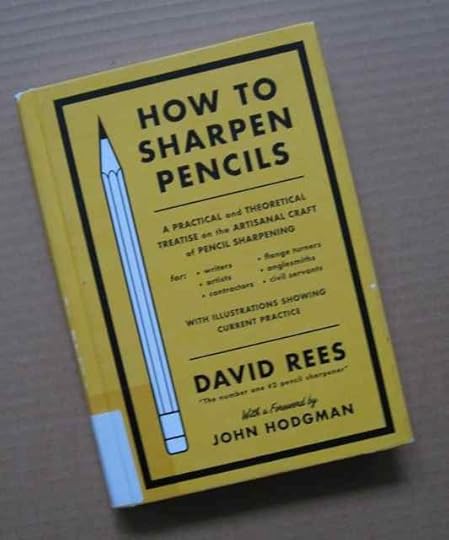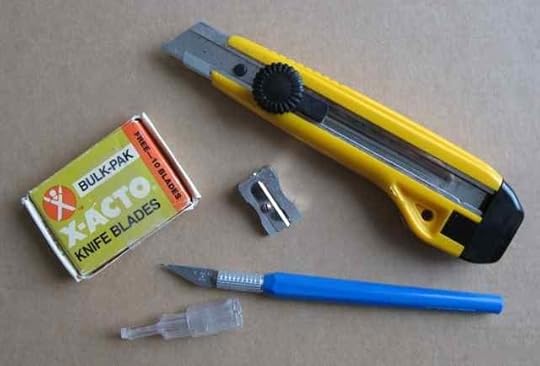On the sharpening of pencils
Over the holidays, members of my extended family were discussing real (as opposed to mechanical) pencils. This was in relation to a gift my sister received: a real pencil, and an eraser. It pleased her a great deal. I think there was even a hand-held sharpener included in the package, which was limited to a value of $4. (We performed a holiday-gift experiment this year. It was an amazing success, and we'll do it again.)
The giver of the gift would have provided an artisan-sharpened pencil, except that the still relatively modest cost (in the gift realm) exceeded the constraints put on that part of the present-finding exercise. But the topic of pencil sharpening came up, and we considered for more than a passing moment some aspects of the craft, with which most of us were of an age to have been acquainted in at least an amateur or student's role.
As I was leaving the public library the other day, the following appropriately colored book caught my eye:
So, of course, I had to pick it up.
Here's a brief quote from page 157, with one bracketed comment:
For readers of a certain age [that includes me], the sight (and sounds) of a wall-mounted hand-crank pencil sharpener is as powerfully nostalgic as the odor of tiny milk cartons, the heft of a chalkboard eraser, or the rap of an unforgiving teacher's ruler across the knuckles.
Those happy days, alas, are long gone. . . .
Consider what follows a re-introduction to a set of skills that were likely central to your portfolio in the distant past, but now risk fading into the ledger of the lost arts. Let us turn our contemporary sensibilities to the wall-mounted hand-crank sharpener and rediscover what pleasures remain thereby.
Urban explorers make a habit of carrying a #2 pencil on their person in case they stumble upon a wall-mounted sharpener in one of the decrepit buildings they trespass.
(Hmm. I travel with a spindle, in case of fiber encounters, and a tiny bit of fiber, in case of spinning-tool encounters. How far-fetched is Rees's observation about the carrying of pencils, just in case?)
What was interesting to me in reading this book (and yes, I read the whole thing) was how many of the pencil-sharpening tools and techniques were completely familiar, and the realization that for many people these would be objects as foreign as a spindle, and the associated skills as peculiar-seeming as the making of yarn by hand: knives, single-burr and double-burr hand-crank sharpeners, single-blade pocket sharpeners, and even electric sharpeners (the chapters on these and on mechanical pencils were among the most enlightening). I even learned something: I'd missed the precise application techniques for the multiple-hole, multiple-stage pocket sharpeners, even though they were around and I'd used them often! I also became aware of a number of fine points [sorry . . . or not {grin}] about pencil-sharpening that I considered common knowledge, and I refined [ . . . ] my knowledge in ways that will improve my sharpening technique in the future.
Oddly, the book was a good (if quick) read. The author was previously a political cartoonist, and a census-taker (the precipitating occupation in his career change), both of which occupations explain a lot. The pages contain good, serious information. Note: The book is not suitable reading for most children, due to levels and types of vocabulary. The only chapter I snoozed through was the one on celebrities, but then I don't follow celebrities so I may have missed something that others will appreciate.
Here's an interview author (and pencil sharpener) David Rees did on Portland TV before a book-signing at Powell's. (I wonder: does he sign in pencil??) The prices of pencil-sharpening have increased since the interview aired. An artisanally sharpened pencil would be out of reach of all but the largest of our family's gift-giving categories ($0, $4, $40). If one of us received such a pencil, it would be our Big Gift for the year. (Although with the remaining $5, the giver could also provide a pencil, a sharpener, and an eraser—but, unfortunately, not also the book that provides training in how to use the first two.) It's also true that Rees may actually be making something of a living at his chosen pursuit now.
All this certainly does put my own focus on sheep and wool into perspective. I'm not entirely sure what perspective. I'm working on that.





